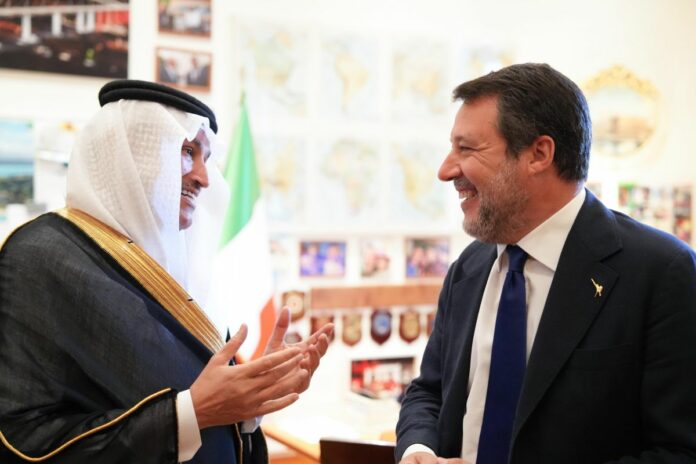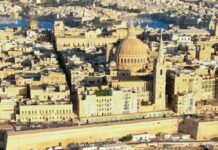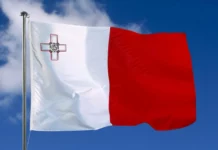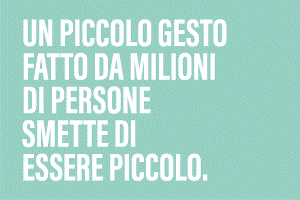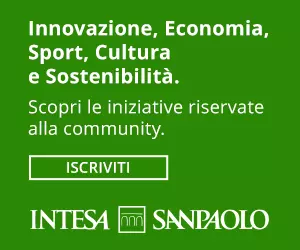ROME (ITALPRESS) – There are numerous opportunities for collaboration between Italy and Saudi Arabia in the field of infrastructure. This was the key takeaway from a meeting between Italian Deputy Prime Minister and Minister of Infrastructure and Transport, Matteo Salvini, and the Saudi Minister of Transport and Logistic Services, Saleh Al-Jasser.
“Even now, several Italian entities are directly involved in major railway and metro projects, as well as in the construction of iconic architectural works,” the Italian Ministry of Infrastructure and Transport (MIT) stated in a press release. “Among these, the Diriyah Contemporary Art Museum, designed by Studio Schiattarella and inaugurated on November 25, and the Al-Ula concert hall, designed by Studio Giò Forma together with Black Engineering, which hosted the High-Level Roundtable during the visit of the Italian Prime Minister.”
Here are Riyadh’s main infrastructure initiatives:
* NEOM Megacity: Aiming to boost its population by 2045, the project includes The Line, the industrial city of Oxagon, and Trojena. One goal is to build the elevated stadium for the 2034 World Cup final.
* Red Sea Global Development: A $16 billion investment featuring luxury hotels, marinas, and a cruise terminal. The focus is on ultra-luxury and regenerative tourism. Nearly all major international luxury hotel chains are participating.
* Qiddiya Entertainment City: A $20 billion development including six theme parks and a new stadium.
* King Salman International Airport: A $33 billion project.
* Diriyah Gate: Valued at $22.1 billion.
* New Murabba Centre: Featuring the Mukaab, the largest building in the world, at the center of a $50 billion project.
* ROSHN Residential Development: Aims to deliver 400,000 housing units by 2030.
Other major projects in the capital include the $2.7 billion King Salman Park (one of the world’s largest urban parks), the 135-km Sports Boulevard (completion expected in 2026), and the King Abdullah Financial District (KAFD), which is operational but not yet fully running. The Transport Minister also launched a Special Logistics Zone in Riyadh, with Apple as its first major investor.
Saudi Arabia’s railway network, which currently transports 25 million tons of goods per year, includes four main lines: SAR East, SAR North trunkline, Haramain High-Speed Railway, and the Mecca Metro. Plans are in place to expand the network from 5,000 km to 8,000 km of track, with 50% of logistics and transport funding allocated to rail improvements.
Regarding ports:
* Jeddah Port handles 65% of the country’s maritime imports.
* King Abdul Aziz Port in Dammam is the largest Gulf port.
* King Fahad Industrial Port in Yanbu is the largest in size and capacity, primarily serving the hydrocarbons sector.
Saudi Arabia has 26 airports, including seven international hubs:
* King Abdulaziz International Airport (Jeddah) is the largest and busiest, with a terminal dedicated to Hajj pilgrims.
* King Khalid International Airport (Riyadh) is the second largest.
* Dammam Airport is the third largest and the main gateway to Gulf states.
* Prince Mohammed bin Abdulaziz Airport in Medina serves mainly pilgrim traffic.
The aviation sector aims to increase passenger capacity from 100 million to 330 million by 2030, anchored by the $33 billion King Salman International Airport project, which aims to serve 120 million passengers annually. In addition, the new NEOM Airport aims to handle 20 million passengers by 2030.
Italian companies are particularly interested in:
* The extension of Metro Line 2 (valued at about $3 billion) and the construction of new Line 7 (valued at about $20 billion). Riyadh’s metro, officially inaugurated remotely by King Salman bin Abdulaziz Al Saud on November 28, currently has six lines and is the longest driverless metro system in the world. In its first two months of operation, it exceeded 18 million passengers, with the Financial District (KAFD) station, designed by Zaha Hadid, alone seeing 3 million passengers.
* Q-Express, a high-speed rail line linking Riyadh Airport with Qiddiya.
* Extension of the Landbridge rail project linking Jeddah to Jubail.
* New Riyadh International Airport.
* NEOM developments (The Line, Oxagon, and Trojena).
* Railway connections to the King Salman Energy Park, an industrial city developed by Aramco in the Eastern Province.
Salvini reiterated to his counterpart Saleh Al-Jasser “Italy’s willingness to collaborate and leverage the expertise, both public and private, that our country offers.” He also emphasized “MIT’s commitment to other sectors such as housing and water.”
– photo press office ministero delle Infrastrutture e dei Trasporti –
(ITALPRESS).






